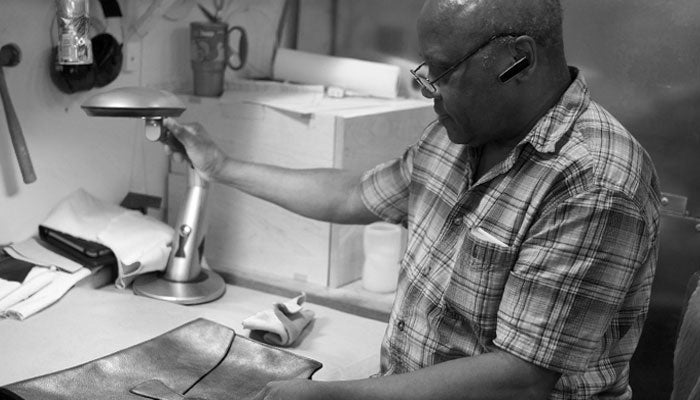The Biography: Nnak

Our very first employee, Nnak is an exceptionally trained leather craftsman who has been integral to our success over the years. Here, Liz interviews him to find out more about his manufacturing background and why he's proud to work at Lotuff.
You’re highly educated in the art of manufacturing leather goods, and you began that education at a fairly young age. Can you tell me more about your path and how it’s led to where you are today?
Well, I think it was when I was still in high school in Uganda that I started making leather goods. I did some work with school at a shoe factory, and then about three years later later I started my own cottage industry. After about two years, in 1972, I went over to Nairobi and started another business, making things like bags and belts. I did ostrich, crocodile, and snake farming for that. Five years later, I started at Nairobi’s United States International University, taking classes towards a degree in business administration. After that, I worked with my own business for a while, and then in 1988 I went to London to attend Cordwainers at London College of Fashion for my diploma in leather goods. In 1990, after I had my degree, I went home to Uganda to do mechanized industry, but I found there was a lot of governmental corruption there. It was no longer possible for me to keep up my leather goods and footwear production; I just didn’t have a lot of support and I couldn’t sustain my business. So in 1994, I came to America to start an industry here. I started off in Santa Monica, doing footwear repairs, and then I began creating leather goods again with ostrich, emu, and alligator. I made them all in my home and obtained skins from farmers who didn’t have enough demand for them. In 2000, I moved to Boston, some years passed- then Lotuff opened, and I began working here.

So you’ve been with Lotuff since the very beginning. What’s the best change you’ve seen happen in the company since then?
Basically, compared to the beginning, we just have so much more now than we did then. For example, we have three sewing machines now compared to the one we had at the start, so we’re able to work much faster. It used to be a lot of work to get everything done with such a small team, especially when some of us were gone for business travel and shows. As time has gone on, though, we’ve been able to buy more machines and leather, and hire even more talented artisans to put them to use. We have enough people and enough machines at this point that everyone here has the ability to really find their own speciality and stick with it. Everyone has something they’re particularly good at, and now that we’ve grown, there’s a freedom to move around and discover it without slowing down production. It’s different now; our production is so good.
Besides cow hides, you mention that you’ve also worked with more exotic materials such as ostrich and alligator. How do those all compare to each other?
Exotic skins are more delicate, whereas cow is not very delicate- it’s a different kind of leather. I’ve worked with lambskin, too and that was definitely a lot more fragile. You have to be especially careful, even making sure you have short nails to work with that kind of material so you don’t scratch it. Exotic skins are delicate in the way that you have to know the leather and you have to be very careful with which type of machine you are using. I loved working with them, though; I made products with exotic skins for many years, even with fish skins. The hides are always much smaller compared to the big rolls of leather we have here.

Many of the bags you work on are shipped out to destinations around the world. Which of those products are you most proud of having worked on?
To me, [I’m most proud of] the Tripps and the portfolios. But I’m proud of all of them! Since I first started working here, we’ve never had a return of something that cannot be sold due to quality issues. Because all of our bags are laminated, I have a hand in making most of them, and I do cutting for some as well. That’s the the most important step — cutting — so I’m proud when I can do that well. So all that work and refinement, whatever I have done or touched along the way, then I’m proud because we’ve sold it.
Since you mostly do lamination out in the workshop, can you tell me more about that process and why it’s so important for our bags?
Lamination is used as lining, so instead of lining a bag with only one piece of leather, you use two pieces so it appears the same on both sides. It’s all done manually, after splitting. I get the pieces of leather, then lay them out according to their sizes, glue them, put them on a rack and wait for it to dry, then I’ll use my own hands or or a machine to press it- the more pressure you use, the stronger it will all adhere. And then those laminated pieces get pushed through the machine and left to dry. Doing this makes our bags stronger, and it looks cleaner. They become durable. As a designer, you must take into account the thickness of each piece, especially when making small items, so that everything looks and feels right; you need a good knowledge of what you're going to make and what it’s going to be used for.